

Compact Muon Solenoid
LHC, CERN
| CMS-BPH-20-004 ; CERN-EP-2021-020 | ||
| Observation of a new excited beauty strange baryon decaying to $\Xi_{\mathrm{b}}^{-}\pi^{+}\pi^{-}$ | ||
| CMS Collaboration | ||
| 8 February 2021 | ||
| Phys. Rev. Lett. 126 (2021) 252003 | ||
| Abstract: The $\Xi_{\mathrm{b}}^{-}\pi^{+}\pi^{-}$ invariant mass spectrum is investigated with an event sample of proton-proton collisions at $\sqrt{s} = $ 13 TeV, collected by the CMS experiment at the LHC in 2016-2018 and corresponding to an integrated luminosity of 140 fb$^{-1}$. The ground state $\Xi_{\mathrm{b}}^{-}$ is reconstructed via its decays to $\mathrm{J}/\psi \Xi^{-}$ and $\mathrm{J}/\psi \Lambda \mathrm{K}^{-}$. A narrow resonance, labeled $\Xi_{\mathrm{b}}(6100)^{-}$, is observed at a $\Xi_{\mathrm{b}}^{-}\pi^{+}\pi^{-}$ invariant mass of 6100.3 $\pm$ 0.2 (stat) $\pm$ 0.1 (syst) $\pm$ 0.6 ($\Xi_{\mathrm{b}}^{-}$) MeV, where the last uncertainty reflects the precision of the $\Xi_{\mathrm{b}}^{-}$ baryon mass. The upper limit on the $\Xi_{\mathrm{b}}(6100)^{-}$ natural width is determined to be 1.9 MeV at 95% confidence level. Following analogies with the established excited $\Xi_{\mathrm{c}}$ baryon states, the new $\Xi_{\mathrm{b}}(6100)^{-}$ resonance and its decay sequence are consistent with the orbitally excited $\Xi_{\mathrm{b}}^{-}$ baryon, with spin and parity quantum numbers $J^P=$ 3/2$^-$. | ||
| Links: e-print arXiv:2102.04524 [hep-ex] (PDF) ; CDS record ; inSPIRE record ; HepData record ; CADI line (restricted) ; | ||
| Figures | Summary | Additional Figures | References | CMS Publications |
|---|
| Figures | |

png pdf |
Figure 1:
The $ \Xi_{\mathrm{b}}(6100)^{-} \to \Xi_{\mathrm{b}}^{-}\pi^{+}\pi^{-} $ decay topology, where the $\Xi_{\mathrm{b}}^{-}$ decays to $\mathrm{J}/\psi \Xi^{-} $ (left) or to $\mathrm{J}/\psi \Lambda \mathrm{K^{-}} $ (right). The numbers in blue are average decay lengths. |
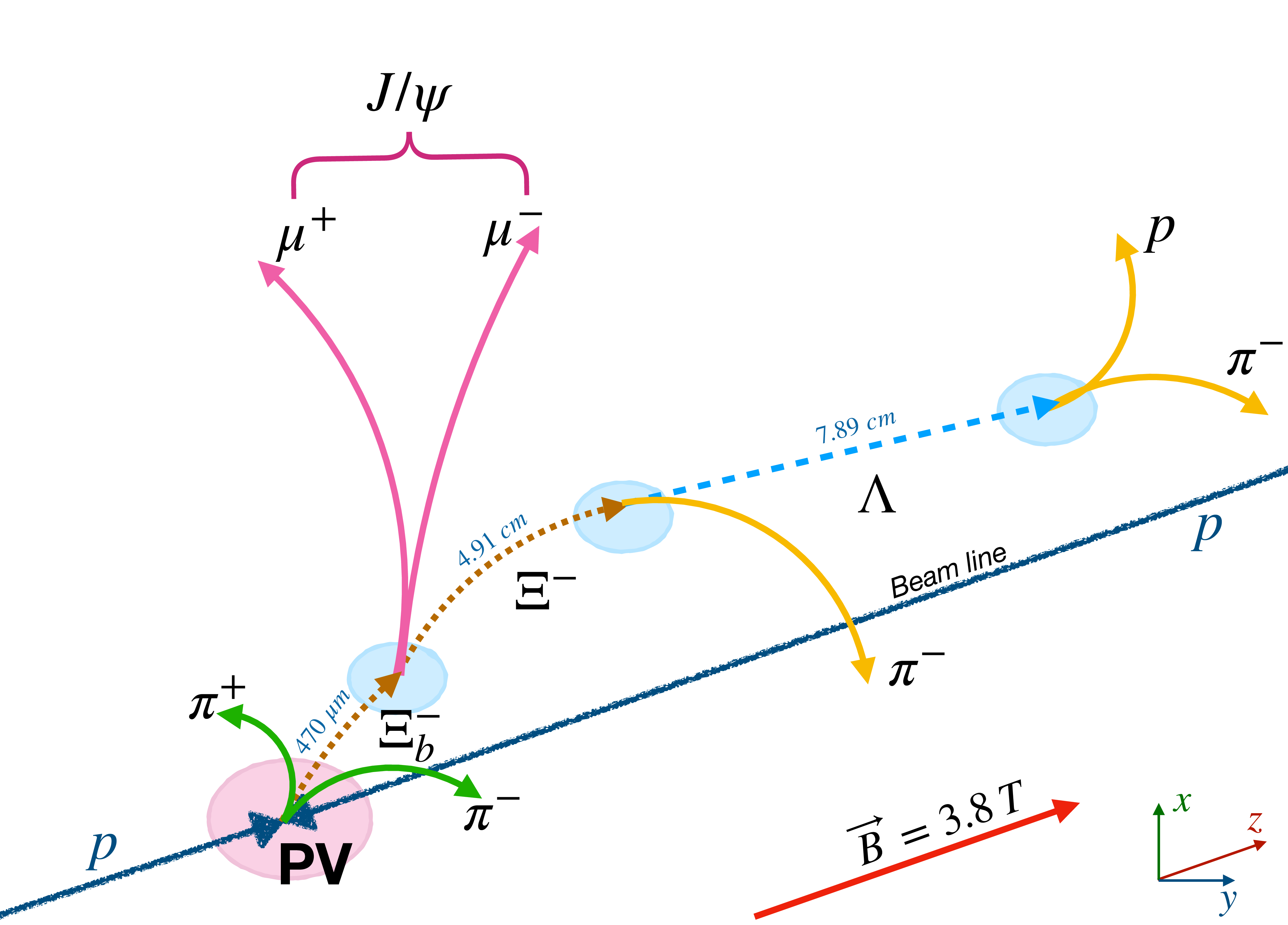
png pdf |
Figure 1-a:
The $ \Xi_{\mathrm{b}}(6100)^{-} \to \Xi_{\mathrm{b}}^{-}\pi^{+}\pi^{-} $ decay topology, where the $\Xi_{\mathrm{b}}^{-}$ decays to $\mathrm{J}/\psi \Xi^{-} $. $\mathrm{J}/\psi \Lambda \mathrm{K^{-}} $. The numbers in blue are average decay lengths. |
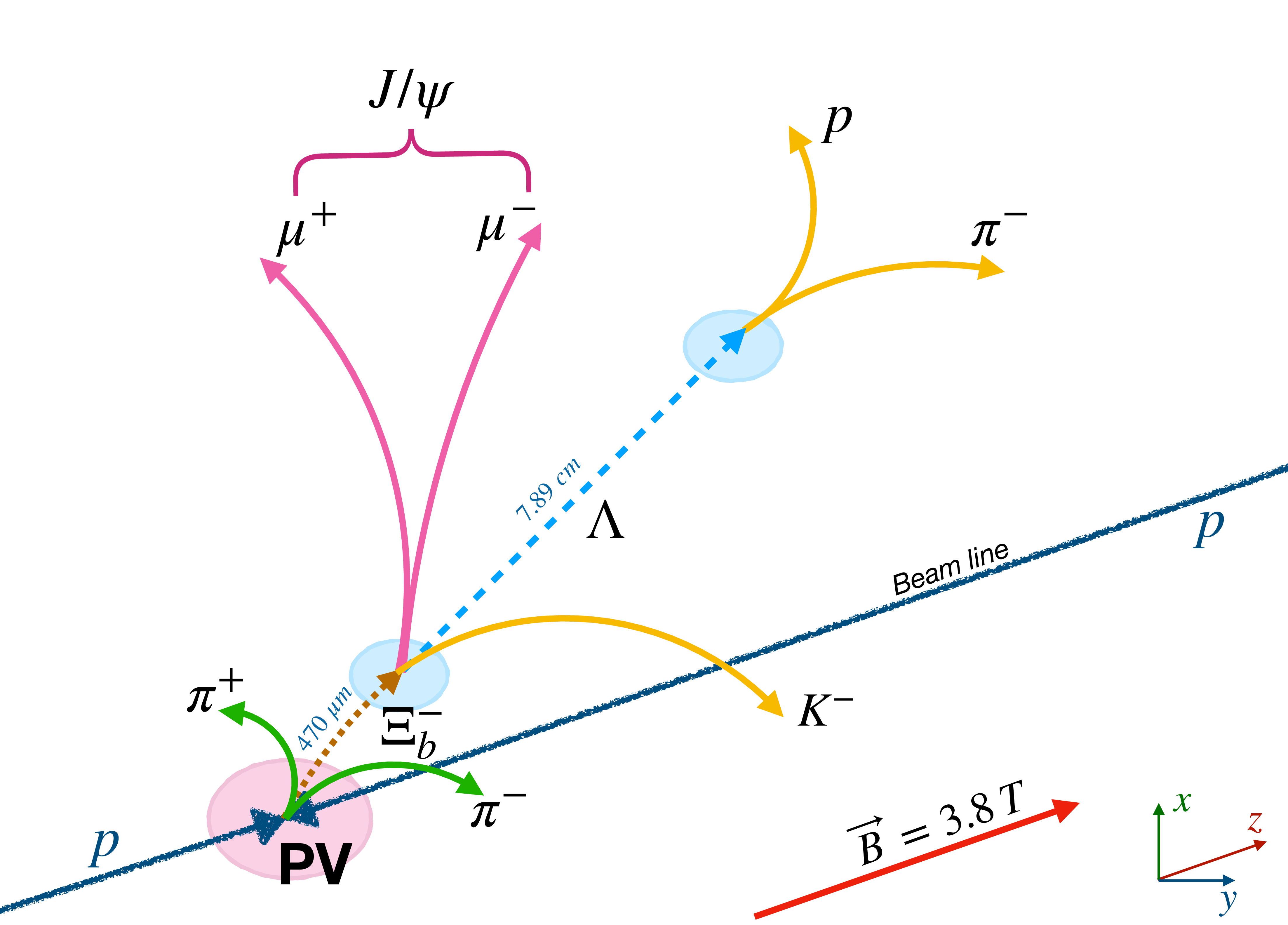
png pdf |
Figure 1-b:
The $ \Xi_{\mathrm{b}}(6100)^{-} \to \Xi_{\mathrm{b}}^{-}\pi^{+}\pi^{-} $ decay topology, where the $\Xi_{\mathrm{b}}^{-}$ decays to $\mathrm{J}/\psi \Xi^{-} $. $\mathrm{J}/\psi \Lambda \mathrm{K^{-}} $. The numbers in blue are average decay lengths. |

png pdf |
Figure 2:
Invariant mass distributions of the selected $\Xi_{\mathrm{b}}^{-}$ candidates in the ${\mathrm{J}/\psi \Xi^{-}}$ (left) and ${\mathrm{J}/\psi \Lambda \mathrm{K^{-}}}$ (right) decay channels with the fit results superimposed. The vertical solid (dashed) lines show the mass windows discussed in the text and used in the reconstruction of the ${\Xi_{\mathrm{b}}^{-} \pi^{+} \pi^{-}}$ candidates in ${\mathrm{J}/\psi \Xi^{-}}$ and ${\mathrm{J}/\psi \Lambda \mathrm{K^{-}}}$ ($\mathrm{J}/\psi \Sigma^{0} \mathrm{K^{-}} $) channels. |
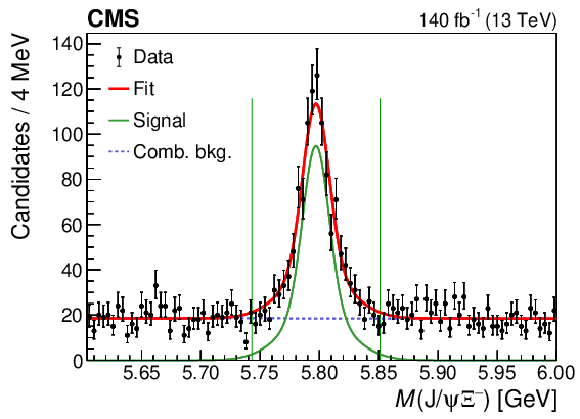
png pdf |
Figure 2-a:
Invariant mass distribution of the selected $\Xi_{\mathrm{b}}^{-}$ candidates in the ${\mathrm{J}/\psi \Xi^{-}}$ ${\mathrm{J}/\psi \Lambda \mathrm{K^{-}}}$ decay channel with the fit results superimposed. The vertical solid line shows the mass window discussed in the text and used in the reconstruction of the ${\Xi_{\mathrm{b}}^{-} \pi^{+} \pi^{-}}$ candidates in the ${\mathrm{J}/\psi \Xi^{-}}$ channel. |
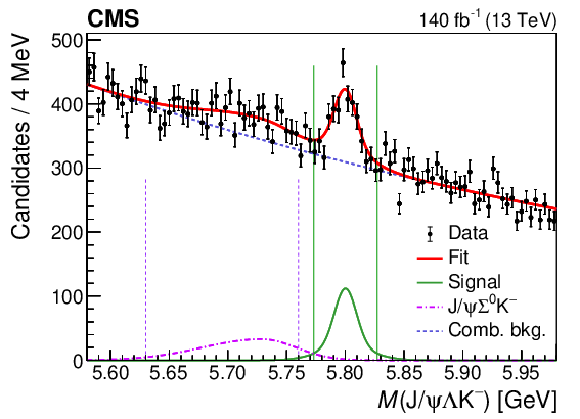
png pdf |
Figure 2-b:
Invariant mass distribution of the selected $\Xi_{\mathrm{b}}^{-}$ candidates in the ${\mathrm{J}/\psi \Lambda \mathrm{K^{-}}}$ decay channel with the fit results superimposed. The vertical solid (dashed) lines show the mass windows discussed in the text and used in the reconstruction of the ${\Xi_{\mathrm{b}}^{-} \pi^{+} \pi^{-}}$ candidates in the ${\mathrm{J}/\psi \Lambda \mathrm{K^{-}}}$ ($\mathrm{J}/\psi \Sigma^{0} \mathrm{K^{-}} $) channel. |
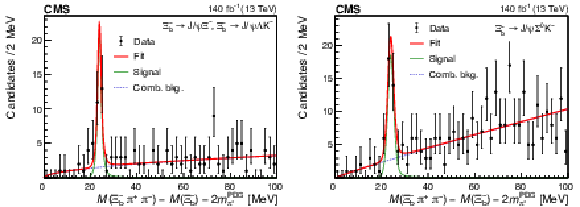
png pdf |
Figure 3:
Distributions of the invariant mass difference ${\Delta M}$ for the selected ${\Xi_{\mathrm{b}}^{-} \pi^{+} \pi^{-}}$ candidates, with the $\Xi_{\mathrm{b}}^{-}$ reconstructed in the ${\mathrm{J}/\psi \Xi^{-}}$ and ${\mathrm{J}/\psi \Lambda \mathrm{K^{-}}}$ channels (left) or partially reconstructed in the $\mathrm{J}/\psi \Sigma^{0} \mathrm{K^{-}} $ channel (right). The result of the simultaneous fit is also shown. |
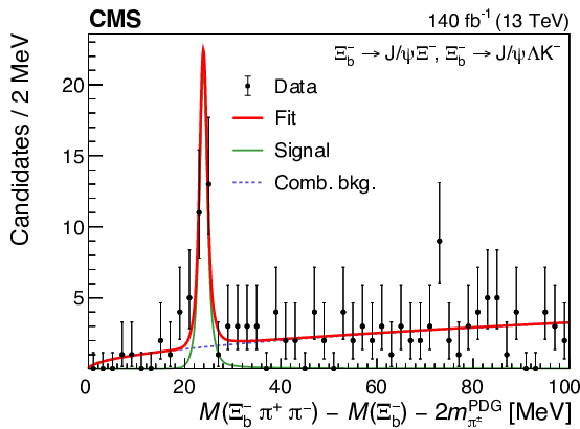
png pdf |
Figure 3-a:
Distribution of the invariant mass difference ${\Delta M}$ for the selected ${\Xi_{\mathrm{b}}^{-} \pi^{+} \pi^{-}}$ candidates, with the $\Xi_{\mathrm{b}}^{-}$ reconstructed in the ${\mathrm{J}/\psi \Xi^{-}}$ and ${\mathrm{J}/\psi \Lambda \mathrm{K^{-}}}$ channels. The result of the simultaneous fit is also shown. |
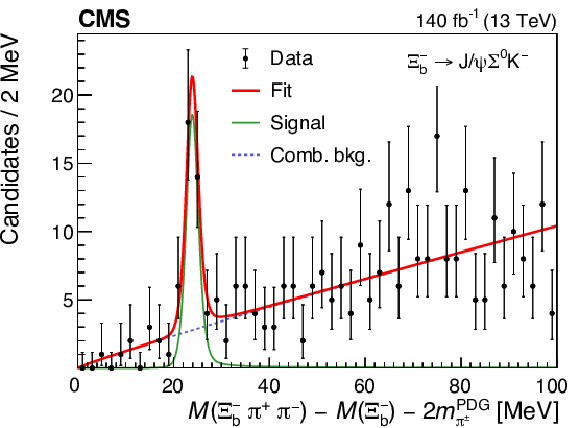
png pdf |
Figure 3-b:
Distribution of the invariant mass difference ${\Delta M}$ for the selected ${\Xi_{\mathrm{b}}^{-} \pi^{+} \pi^{-}}$ candidates, with the $\Xi_{\mathrm{b}}^{-}$ partially reconstructed in the $\mathrm{J}/\psi \Sigma^{0} \mathrm{K^{-}} $ channel. The result of the simultaneous fit is also shown. |
| Summary |
| In summary, we report the observation of a new excited beauty strange baryon, decaying to $\Xi_{\mathrm{b}}^{-}\pi^{+}\pi^{-}$. The analysis uses proton-proton collision data collected by the CMS experiment at $\sqrt{s} = $ 13 TeV, corresponding to an integrated luminosity of 140 fb$^{-1}$. The measured mass difference of this state is $M(\Xi_{\mathrm{b}}(6100)^{-}) - M(\Xi_{\mathrm{b}}^{-}) - 2\,m^{\text{PDG}}_{\pi^{\pm}} = $ 24.14 $\pm$ 0.22 (stat) $\pm$ 0.05 (syst) MeV. The known $\Xi_{\mathrm{b}}^{-}$ mass of 5797.0 $\pm$ 0.6 MeV [20] is used to obtain $ M(\Xi_{\mathrm{b}}(6100)^{-}) =$ 6100.3 $\pm$ 0.2 (stat) $\pm$ 0.1 (syst) $\pm$ 0.6 ($\Xi_{\mathrm{b}}^{-}$) MeV. It is particularly remarkable that if the $\Xi_{\mathrm{b}}(6100)^{-}$ baryon were only 13 MeV heavier, it would be above the $\Lambda_{\mathrm{b}}^{0}\mathrm{K}^{-}$ mass threshold and could decay to this final state. The natural width of this resonance is compatible with zero and a 95% confidence level upper limit of 1.9 MeV has been determined.Following analogies with the established excited $\Xi_{\mathrm{c}}$ baryon states [20], and considering several theoretical predictions [12, 13, 21], the new $\Xi_{\mathrm{b}}(6100)^{-}$ resonance and its decay sequence are consistent with the orbitally excited $\Xi_{\mathrm{b}}^{-}$ baryon, with the light diquark spin $j_{\mathrm{qs}}=$ 1 and $J^P=$ 3/2$^-$. This suggests that it is the beauty analogue of the $\Xi_{\mathrm{c}}(2815)$ baryon [41]. The observation of this baryon and the measurement of its properties provide information that should help to distinguish between different theoretical models used to calculate the properties of the excited $\Xi_{\mathrm{b}}$ states. |
| Additional Figures | |

png pdf |
Additional Figure 1:
Quark spin configurations for the lightest $\Xi_{\mathrm{b}}$ isodoublets, q corresponds to up and down quarks for $\Xi_{\mathrm{b}}^{0}$ and $\Xi_{\mathrm{b}}^{-}$, respectively. Here $j_{\mathrm{q} \mathrm{s}}$ denotes the light diquark spin, $J^P$ denotes the total spin-parity of $\Xi_{\mathrm{b}}$ baryon and $L$ denotes the orbital angular momentum between the light diquark and the b quark. |
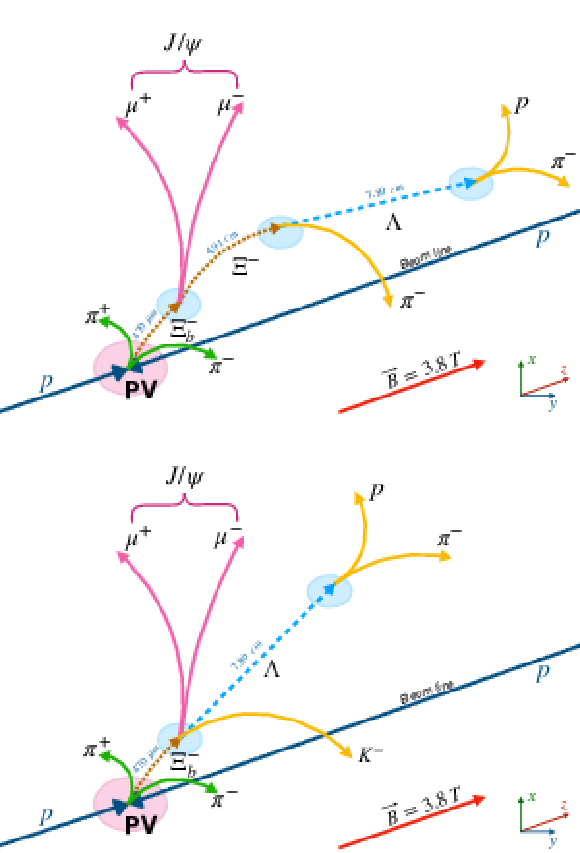
png pdf |
Additional Figure 2:
$\Xi_{\mathrm{b}} (6100)^-\to \Xi_{\mathrm{b}}^{-} \pi^{+} \pi^{-} $ decay topology, where the $\Xi_{\mathrm{b}}^{-}$ decays to $\mathrm{J}/\psi \Xi^{-} $ (top) or to $\mathrm{J}/\psi \Lambda \mathrm{K^{-}} $ (bottom). The numbers in blue are average decay lengths, calculated as $c\tau $. |
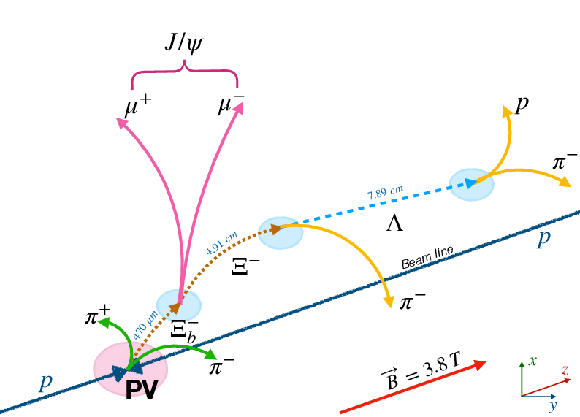
png pdf |
Additional Figure 2-a:
$\Xi_{\mathrm{b}} (6100)^-\to \Xi_{\mathrm{b}}^{-} \pi^{+} \pi^{-} $ decay topology, where the $\Xi_{\mathrm{b}}^{-}$ decays to $\mathrm{J}/\psi \Xi^{-} $. The numbers in blue are average decay lengths, calculated as $c\tau $. |
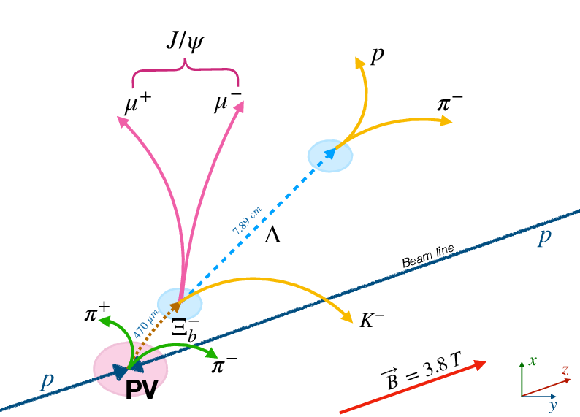
png pdf |
Additional Figure 2-b:
$\Xi_{\mathrm{b}} (6100)^-\to \Xi_{\mathrm{b}}^{-} \pi^{+} \pi^{-} $ decay topology, where the $\Xi_{\mathrm{b}}^{-}$ decays to $\mathrm{J}/\psi \Lambda \mathrm{K^{-}} $. The numbers in blue are average decay lengths, calculated as $c\tau $. |

png pdf |
Additional Figure 3:
Invariant mass distribution of the selected $\Xi_{\mathrm{b}}^{-} \pi \pi $ candidates with no requirements on the $\Xi_{\mathrm{b}}^{-} \pi^{+} $ mass, for the OS (circles) and SS (band) events. The $\Xi_{\mathrm{b}}^{-}$ ground state is fully reconstructed in the $\mathrm{J}/\psi \Xi^{-} $ and $\mathrm{J}/\psi \Lambda \mathrm{K^{-}} $ channels (left) or partially reconstructed in the $\mathrm{J}/\psi \Sigma^{0} \mathrm{K^{-}} $ channel (right). The vertical lines show the masses of the new $\Xi_{\mathrm{b}} (6100)^-$ baryon and of the $\Xi_{\mathrm{b}} (6227)^-$ state, observed by the LHCb Collaboration in the $\Lambda_{\mathrm{b}}^{0} \mathrm{K^{-}} $ and $\Xi_{\mathrm{b}}^{0} \pi^{-} $ decay channels [22]. |
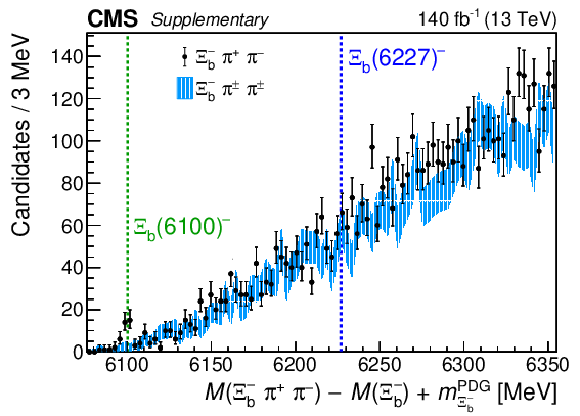
png pdf |
Additional Figure 3-a:
Invariant mass distribution of the selected $\Xi_{\mathrm{b}}^{-} \pi \pi $ candidates with no requirements on the $\Xi_{\mathrm{b}}^{-} \pi^{+} $ mass, for the OS (circles) and SS (band) events. The $\Xi_{\mathrm{b}}^{-}$ ground state is fully reconstructed in the $\mathrm{J}/\psi \Xi^{-} $ and $\mathrm{J}/\psi \Lambda \mathrm{K^{-}} $ channels. The vertical lines show the masses of the new $\Xi_{\mathrm{b}} (6100)^-$ baryon and of the $\Xi_{\mathrm{b}} (6227)^-$ state, observed by the LHCb Collaboration in the $\Lambda_{\mathrm{b}}^{0} \mathrm{K^{-}} $ and $\Xi_{\mathrm{b}}^{0} \pi^{-} $ decay channels [22]. |

png pdf |
Additional Figure 3-b:
Invariant mass distribution of the selected $\Xi_{\mathrm{b}}^{-} \pi \pi $ candidates with no requirements on the $\Xi_{\mathrm{b}}^{-} \pi^{+} $ mass, for the OS (circles) and SS (band) events. The $\Xi_{\mathrm{b}}^{-}$ ground state is partially reconstructed in the $\mathrm{J}/\psi \Sigma^{0} \mathrm{K^{-}} $ channel. The vertical lines show the masses of the new $\Xi_{\mathrm{b}} (6100)^-$ baryon and of the $\Xi_{\mathrm{b}} (6227)^-$ state, observed by the LHCb Collaboration in the $\Lambda_{\mathrm{b}}^{0} \mathrm{K^{-}} $ and $\Xi_{\mathrm{b}}^{0} \pi^{-} $ decay channels [22]. |
| References | ||||
| 1 | D. Ebert, T. Feldmann, C. Kettner, and H. Reinhardt | A diquark model for baryons containing one heavy quark | Z. Phys. C 71 (1996) 329 | hep-ph/9506298 |
| 2 | D. Ebert, R. N. Faustov, and V. O. Galkin | Masses of excited heavy baryons in the relativistic quark model | PLB 659 (2008) 612 | 0705.2957 |
| 3 | E. E. Jenkins | Model-independent bottom baryon mass predictions in the 1/N($ c $) expansion | PRD 77 (2008) 034012 | 0712.0406 |
| 4 | M. Karliner, B. Keren-Zur, H. J. Lipkin, and J. L. Rosner | The quark model and $ \mathrm{b} $ baryons | Annals Phys. 324 (2009) 2 | 0804.1575 |
| 5 | W. Roberts and M. Pervin | Heavy baryons in a quark model | Int. J. Mod. Phys. A 23 (2008) 2817 | 0711.2492 |
| 6 | D. Ebert, R. N. Faustov, and V. O. Galkin | Spectroscopy and Regge trajectories of heavy baryons in the relativistic quark-diquark picture | PRD 84 (2011) 014025 | 1105.0583 |
| 7 | H. Garcilazo, J. Vijande, and A. Valcarce | Faddeev study of heavy baryon spectroscopy | JPG 34 (2007) 961 | hep-ph/0703257 |
| 8 | B. Chen, K.-W. Wei, and A. Zhang | Assignments of $ \Lambda_Q $ and $ \Xi_Q $ baryons in the heavy quark-light diquark picture | EPJA 51 (2015) 82 | 1406.6561 |
| 9 | I. L. Grach, I. M. Narodetskii, M. A. Trusov, and A. I. Veselov | Heavy baryon spectroscopy in the QCD string model | in Proceedings of the 18th International Conference on Particles and nuclei (PANIC08) 2008 | 0811.2184 |
| 10 | Q. Mao et al. | QCD sum rule calculation for P-wave bottom baryons | PRD 92 (2015) 114007 | 1510.05267 |
| 11 | Z.-G. Wang | Analysis of the $ {1/2^-} $ and $ {3/2^-} $ heavy and doubly heavy baryon states with QCD sum rules | EPJA 47 (2011) 81 | 1003.2838 |
| 12 | K.-L. Wang, Y.-X. Yao, X.-H. Zhong, and Q. Zhao | Strong and radiative decays of the low-lying $ S $- and $ P $-wave singly heavy baryons | PRD 96 (2017) 116016 | 1709.04268 |
| 13 | Y. Kawakami and M. Harada | Singly heavy baryons with chiral partner structure in a three-flavor chiral model | PRD 99 (2019) 094016 | 1902.06774 |
| 14 | Z.-Y. Wang, J.-J. Qi, X.-H. Guo, and K.-W. Wei | Spectra of charmed and bottom baryons with hyperfine interaction | CPC 41 (2017) 093103 | 1701.04524 |
| 15 | K. Thakkar, Z. Shah, A. K. Rai, and P. C. Vinodkumar | Excited state mass spectra and Regge trajectories of bottom baryons | NP A 965 (2017) 57 | 1610.00411 |
| 16 | K.-W. Wei et al. | Spectroscopy of singly, doubly, and triply bottom baryons | PRD 95 (2017) 116005 | 1609.02512 |
| 17 | CMS Collaboration | Observation of a new $ \Xi_{\mathrm{b}} $ baryon | PRL 108 (2012) 252002 | CMS-BPH-12-001 1204.5955 |
| 18 | LHCb Collaboration | Measurement of the properties of the $ \Xi_b^{*0} $ baryon | JHEP 05 (2016) 161 | 1604.03896 |
| 19 | LHCb Collaboration | Observation of two new $ \Xi_b^- $ baryon resonances | PRL 114 (2015) 062004 | 1411.4849 |
| 20 | Particle Data Group, P. A. Zyla et al. | Review of particle physics | Prog. Theor. Exp. Phys. 2020 (2020) 083C01 | |
| 21 | B. Chen, K.-W. Wei, X. Liu, and A. Zhang | Role of newly discovered $ \Xi_b(6227)^- $ for constructing excited bottom baryon family | PRD 98 (2018) 031502(R) | 1805.10826 |
| 22 | LHCb Collaboration | Observation of a new $ \Xi_b^- $ resonance | PRL 121 (2018) 072002 | 1805.09418 |
| 23 | LHCb Collaboration | Observation of a new $ \Xi_b^0 $ state | PRD 103 (2021) 012004 | 2010.14485 |
| 24 | LHCb Collaboration | Observation of the $ \varXi^{-}_{b}\to J/\psi\varLambda K^{-} $ decay | PLB 772 (2017) 265 | 1701.05274 |
| 25 | CMS Collaboration | The CMS experiment at the CERN LHC | JINST 3 (2008) S08004 | CMS-00-001 |
| 26 | CMS Collaboration | Performance of the CMS Level-1 trigger in proton-proton collisions at $ \sqrt{s} = $ 13 TeV | JINST 15 (2020) P10017 | CMS-TRG-17-001 2006.10165 |
| 27 | CMS Collaboration | The CMS trigger system | JINST 12 (2017) P01020 | CMS-TRG-12-001 1609.02366 |
| 28 | T. Sjostrand et al. | An introduction to PYTHIA 8.2 | CPC 191 (2015) 159 | 1410.3012 |
| 29 | D. J. Lange | The EVTGEN particle decay simulation package | NIMA 462 (2001) 152 | |
| 30 | E. Barberio, B. van Eijk, and Z. Was | PHOTOS: A universal Monte Carlo for QED radiative corrections in decays | CPC 66 (1991) 115 | |
| 31 | E. Barberio and Z. Was | PHOTOS: A universal Monte Carlo for QED radiative corrections. Version 2.0 | CPC 79 (1994) 291 | |
| 32 | GEANT4 Collaboration | GEANT4--a simulation toolkit | NIMA 506 (2003) 250 | |
| 33 | G. Punzi | Sensitivity of searches for new signals and its optimization | in Proceedings of PHYSTAT 2003, Statistical problems in particle physics, astrophysics and cosmology, p. MODT002 2003 eConf C030908 | physics/0308063 |
| 34 | CMS Collaboration | Performance of the CMS muon detector and muon reconstruction with proton-proton collisions at $ \sqrt{s}= $ 13 TeV | JINST 13 (2018) P06015 | CMS-MUO-16-001 1804.04528 |
| 35 | CMS Collaboration | CMS tracking performance results from early LHC operation | EPJC 70 (2010) 1165 | CMS-TRK-10-001 1007.1988 |
| 36 | CMS Collaboration | Description and performance of track and primary-vertex reconstruction with the CMS tracker | JINST 9 (2014) P10009 | CMS-TRK-11-001 1405.6569 |
| 37 | CMS Collaboration | Search for the X(5568) state decaying into $ \mathrm{B}^{0}_{\mathrm{s}}\pi^{\pm} $ in proton-proton collisions at $\sqrt{s} = $ 8 TeV | PRL 120 (2018) 202005 | CMS-BPH-16-002 1712.06144 |
| 38 | CMS Collaboration | Studies of $ {\mathrm {B}}^{*}_{\mathrm {s}2}(5840)^0 $ and $ {\mathrm {B}}_{{\mathrm {s}}1}(5830)^0 $ mesons including the observation of the $ {\mathrm {B}}^{*}_{\mathrm {s}2}(5840)^0 \rightarrow {\mathrm {B}} ^0 \mathrm {K} ^0_{\mathrm {S}} $ decay in proton-proton collisions at $\sqrt{s} = $ 8 TeV | EPJC 78 (2018) 939 | CMS-BPH-16-003 1809.03578 |
| 39 | CMS Collaboration | Observation of two excited B$ ^+_\mathrm{c} $ states and measurement of the B$ ^+_\mathrm{c} $(2S) mass in $ pp $ collisions at $\sqrt{s} = $ 13 TeV | PRL 122 (2019) 132001 | CMS-BPH-18-007 1902.00571 |
| 40 | CMS Collaboration | Study of excited $ \Lambda_\mathrm{b}^0 $ states decaying to $ \Lambda_\mathrm{b}^0\pi^+\pi^- $ in proton-proton collisions at $ \sqrt{s}= $ 13 TeV | PLB 803 (2020) 135345 | CMS-BPH-19-003 2001.06533 |
| 41 | CLEO Collaboration | Evidence of new states decaying into $\Xi_{\mathrm{c}}*\pi $ | PRL 83 (1999) 3390 | hep-ex/9906013 |
| 42 | J. D. Jackson | Remarks on the phenomenological analysis of resonances | Nuovo Cim. 34 (1964) 1644 | |
| 43 | J. M. Blatt and V. F. Weisskopf | Theoretical nuclear physics | Springer, New York, 1952 , ISBN 978-0-471-08019-0 | |
| 44 | S. S. Wilks | The large-sample distribution of the likelihood ratio for testing composite hypotheses | Annals Math. Statist. 9 (1938) 60 | |
| 45 | G. Cowan, K. Cranmer, E. Gross, and O. Vitells | Asymptotic formulae for likelihood-based tests of new physics | EPJC 71 (2011) 1554 | 1007.1727 |

|
Compact Muon Solenoid LHC, CERN |

|

|

|

|

|

|